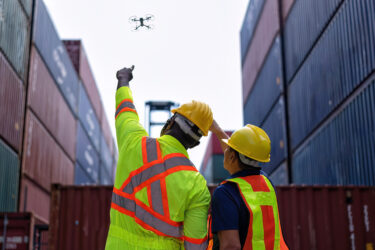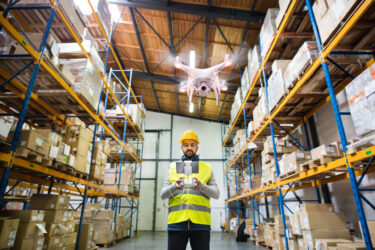

Thinking about agriculture for most of us probably summons to a mind an image of endless fields and livestock. Not often we associate farming with something modern – but the truth is that similarly to any other sector of the economy, it is undergoing a digital transformation. By 2025, the global agriculture analytics market value is expected to reach USD 1.4 billion, which means an average yearly growth of 12.2% since 2020 – the pandemic year that changed everything. What does the digital transformation look like in the most natural sector? In this article you will read how big data in agriculture encourages data driven farming.
Why we need Big Data in agriculture?
As most of the students learn in schools, the ancient Egyptian farmers were dependent on the Nile River – they had to pay attention to its seasonal floodings in order to be able to grow food and industrial crops, which fed them and let them grow their industrial economy. Nowadays, while farmers still have to be aware of nature and its whims, there is a number of technologies available out there, which can help them out in planning and executing activities in order to maximize crop yields.
Can agriculture be done less intuitively?
For years agriculture has been approached as something that is done based on the intuition and wisdom passed between the generations inside one family. However, as the global population keeps on increasing, so do its dietary needs. Even now about 40 countries in the world experience serious hunger, while in 11 there is an alarming lack of food to feed the people.
At the same time, the progressing urbanization and the impact of climate changes decrease the number of available fields. As the ground degrades, becomes dried out, barren, or is simply repurposed for growing cities’ needs, such as highways or new apartments. Smaller countries force also major challenges are also faced by smaller countries which have to consider carefully the use of every square meter of their territory.
All of these needs have led to the introduction of digital transformation in agriculture. New technologies, called agrotech, are helping farmers with making decisions based on data rather than their intuition and claims that “everyone does it the same way”.
How is Big Data analytics used in farming?
Some examples of such novelties include software that helps in monitoring the state of the land, livestock, and equipment. GPS navigation combined with Artificial Intelligence and the Internet of Things enables planning agricultural work in a more efficient and smoother way throughout the year, easily adjusting to various weather conditions and other factors.
Irrigating the land, eliminating pests, applying fertilizers, detecting illnesses among the livestock, and other potential issues even before they occur – the farmers do not have to be alone anymore in their fight, as the existing tools can provide them with extra leverage that will help them care about their land, optimize the use of resources and maximize the profits.
A properly set up infrastructure can also help in managing the crops after they are picked up – monitoring the storage conditions, i.e. proper temperature or humidity level.
As a result, consumers can have access to products that have been grown truly in harmony with nature and the rules of sustainability. What’s more, decreasing the number of bad crops contributes to increasing the amount of food in circulation, thus for example helping in fighting hunger in local communities.

Big Data in agriculture – business use cases
Less food waste, more profits for farmers
Even before the pandemic, about one-third of edible produce in northern and central California remained unharvested in the fields, as the farmers struggled to find people or simply couldn’t pay them as much as they wanted since it would become unprofitable for them.
Advanced machines in connection with automated analytics help in understanding how much of the yield is to be expected and calculating how to pick it up in the most efficient manner. Combining the big data with the general knowledge about the plants’ harvest methods, i.e. how to avoid bruising them or otherwise impact mechanical injuries, will result in creating a cost- and time-effective operational plan.
As a result, the farm should require less workforce and effort to be able to manage all the harvest, which means an opportunity to offer the employees higher pay than before.
How Big Data is boosting food processing
Even if the pickup is optimized, as much as 39-87% of food can get wasted during production, storage, or transportation due to improper handling. Inadequate temperatures, rough transport conditions, or random factors that weren’t taken into account – all of this can contribute to the fact that a farmed food doesn’t even leave the farm.
After the harvest, the produce undergoes several stages of handling:
- processing (which includes cleaning up fruits and removing damaged parts),
- grading (each plant is assessed according to its look and general “ugliness”, as in some parts of the world it is common for the law to rule that only the highest quality products can make it to the store),
- packaging (making sure that the material is protective enough is vital to ensuring the quality of product at all times during the transportation process),
- storage and ripening (adequate temperatures and storing conditions are needed to ensure the proper maintenance of harvested fruits or vegetables).
Processes automated with the help of technologies based on Artificial Intelligence and Internet of Things help in making sure that the produce is being handled correctly at each stage, and is not mismanaged. Taking advantage of sensors and devices that monitor the storage conditions helps in reducing the waste of food. Adequate temperature, humidity, levels of oxygen, carbon dioxide, and ethylene need to be ensured at all times, so as many products can leave the farm in the best state possible, ready for sale.
All of this, if done without the use of the newest technologies, requires a lot of manual labor, and alertness to every sign that something might be wrong. And since we are all only human, mistakes can happen. Thanks to the agrotech, we can limit their numbers and make sure that the farm will get the most profit possible out of what was harvested.
Optimizing the use of soil
No piece of soil is the same as the other one, especially in times of climate change. Even if the family is used to one particular way of farming or selecting specific crops, the world around is changing – more produce than ever is needed, while at the same the weather conditions are getting less favorable for growing any plants.
When the ground is getting dry or giving less produce than it used to and the rainfall patterns constantly change, it’s time to introduce data analytics and precision agriculture, also called site-specific crop management.
How GPS, drones, IoT can help smart farming
Sensors connected to the Internet of Things provide insight into operations of a particular farm, providing granular data on soil conditions, and enable combining gained information with general knowledge about the location, i.e. expected weather, water availability, or proneness to pest infestations.
Bringing the GPS-based data in the game also allows measuring the organic matter content, moisture or nitrogen levels, as well as many other variables that are important in farming. Additionally, drones can be used to create topographic maps, which will suggest to the farmer how to optimize crop care: watering, fertilizing, etc.
Such a set-up will result in increasing the efficiency of the activities undertaken on the farmland, as well as let farmers make more informed decisions, i.e. on applying pesticides and fertilizers, or selection of crops to be harvested.
Data driven farming is cost-effective
The adoption rate of the big data in agriculture drives not only less food waste and more informed decisions but also allows farmers to budget in a better way. Technology that addresses the challenges related to food and agriculture is expected to generate savings valued at about USD 2.3 trillion. More informed decisions can translate to increased farming productivity, improved efficiency of the operations, and reducing food waste.
The outside expertise based on data can also be of great use to farmers who have been cultivating the land for ages, having this activity passed down from generation to generation. Often they had to base their decisions on their intuition or uncertain predictions. Consulting with other farmers does not always result in a conclusion, especially if everyone’s knowledge comes from their family and considering that every farm might face slightly different challenges. Bringing in an outside expert on the other hand is often an expensive affair.
Putting the technology to the work resolves the matter of getting an impartial look at the state of affairs. Even if setting up the infrastructure is more costly than predicted, the invested money will bring profit soon enough when the yield is larger and better in comparison to the previous years.
Optimizing the agricultural supply chain
Tools provided by agrotech are also helpful for other stakeholders of the agricultural supply chain. While farmers and producers can use the technology for their benefit, other parties at all stages of the supply chain can also profit off these. Each fruit or vegetable that is sold to a store or otherwise processed, has to undergo a long journey before it makes it to the shelves where it can be picked up by customers.
What’s more, the customers are also likely to store the purchase for some more days, so the product must be able to stay edible for a long time while maintaining all of the unique qualities that make the customers want it.
Between food processing and production, automated systems can help in optimizing the fleet management and deliveries between various locations, taking into account specific requirements of each plant, whether it is avocado or apple. Sensors and monitors preventing potential leaks or spillage will ensure that the highest quality of the produce is maintained at all stages.
Conclusion
With the rising global need for food, as well as the weather conditions getting worse all across the globe (droughts, tornadoes, etc.), it is vital that there is no food waste and that farmers are able to maximize the yield from their land. As the agrotech innovations are gaining in significance, it’s expected that farming will stop being an area of intuition, and start being driven with specific expertise that will be needed to feed the growing population of the world.
Big Data in Agriculture R&D projects
Data collection is an important starting point when thinking about big data in agriculture. It is also crucial for many precision farming applications. AFarCloud project focuses on both problems and DAC.digital is one of the partners in the consortium looking for new solutions for modern farming. AFarCloud has a budget of EUR 16.6 million and 59 participants from 14 countries. AFarCloud will provide a distributed platform for autonomous farming that will allow the integration and cooperation of agriculture Cyber-Physical Systems in real-time in order to increase efficiency, productivity, animal health, food quality, and reduce farm labor costs. The project has received funding from the ECSEL Joint Undertaking (JU). Grant agreement No 783221.




